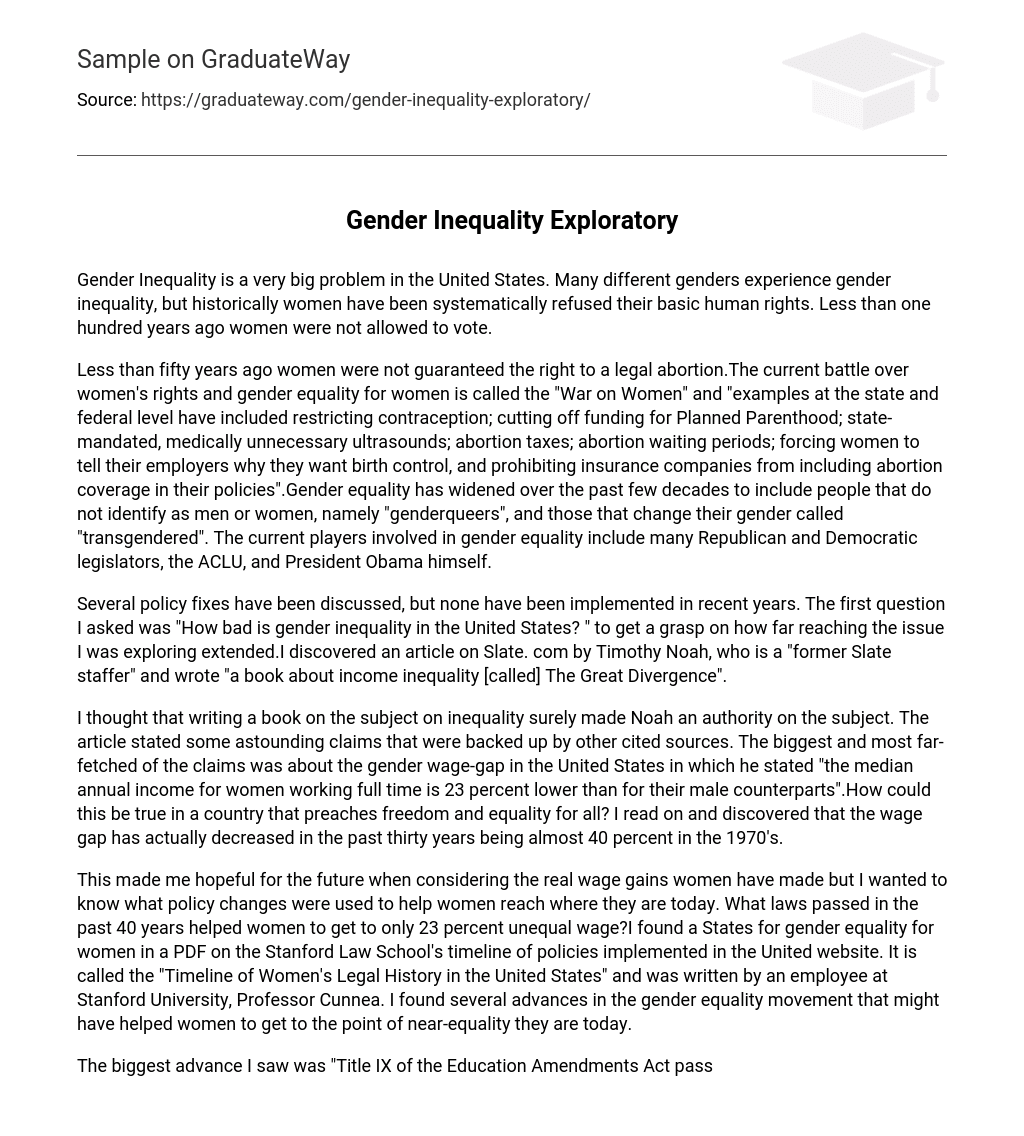Gender Inequality is a very big problem in the United States. Many different genders experience gender inequality, but historically women have been systematically refused their basic human rights. Less than one hundred years ago women were not allowed to vote.
Less than fifty years ago women were not guaranteed the right to a legal abortion.The current battle over women’s rights and gender equality for women is called the “War on Women” and “examples at the state and federal level have included restricting contraception; cutting off funding for Planned Parenthood; state-mandated, medically unnecessary ultrasounds; abortion taxes; abortion waiting periods; forcing women to tell their employers why they want birth control, and prohibiting insurance companies from including abortion coverage in their policies”.Gender equality has widened over the past few decades to include people that do not identify as men or women, namely “genderqueers”, and those that change their gender called “transgendered”. The current players involved in gender equality include many Republican and Democratic legislators, the ACLU, and President Obama himself.
Several policy fixes have been discussed, but none have been implemented in recent years. The first question I asked was “How bad is gender inequality in the United States? ” to get a grasp on how far reaching the issue I was exploring extended.I discovered an article on Slate. com by Timothy Noah, who is a “former Slate staffer” and wrote “a book about income inequality [called] The Great Divergence”.
I thought that writing a book on the subject on inequality surely made Noah an authority on the subject. The article stated some astounding claims that were backed up by other cited sources. The biggest and most far-fetched of the claims was about the gender wage-gap in the United States in which he stated “the median annual income for women working full time is 23 percent lower than for their male counterparts”.How could this be true in a country that preaches freedom and equality for all? I read on and discovered that the wage gap has actually decreased in the past thirty years being almost 40 percent in the 1970’s.
This made me hopeful for the future when considering the real wage gains women have made but I wanted to know what policy changes were used to help women reach where they are today. What laws passed in the past 40 years helped women to get to only 23 percent unequal wage?I found a States for gender equality for women in a PDF on the Stanford Law School’s timeline of policies implemented in the United website. It is called the “Timeline of Women’s Legal History in the United States” and was written by an employee at Stanford University, Professor Cunnea. I found several advances in the gender equality movement that might have helped women to get to the point of near-equality they are today.
The biggest advance I saw was “Title IX of the Education Amendments Act passes, guaranteeing equal access to academic and athletic resources regardless of gender”.This sounds like a huge advancement to me and was alluded to in Noah’s Slate article on inequality as being very effective in bringing about social progress for women. If education reform has helped the gender equality movement, I wanted to know what other possible solutions are there and what are being implemented in today’s government. What policies are president Obama and members of the house and senate implementing to continue to help with gender inequality? I found an article on Whitehouse.
ov that explained the President’s current policies to help promote gender equality called “Fact Sheet: The Obama Administration’s Comprehensive Efforts to Promote Gender Equality and Empower Women and Girls Worldwide”.I thought that the best place to find information about government policy was a government website. The most prominent policy I found was “launching new initiatives to bolster women’s economic empowerment” by helping spur economic growth in communities of women.I thought that this was interesting and very capitalist of the US government, but it makes sense.
Economic independence and economic growth help empower people of all stripes so it follows that women would be positively affected by this policy. Gender inequality is a persisting issue in the United States that still needs to be addressed by citizens and policy makers alike. Stereotyping and backward traditions not based in science seem to be the biggest problems facing the gender equality movement.Comprehensive education reform like in many social issues seems to be a possible solution.
I didn’t find much information on how gender inequality affected non-cisgendered people but I may be able to find some if I look a little harder and for longer. The LGBTQ community resources might be a good place to look as well as to find a person to interview on the obstacles they have faced due to their sexual orientation and gender. I hope to discover a way to enact lasting gender equality progression by the end of this semester by exploring social policies already in place.





